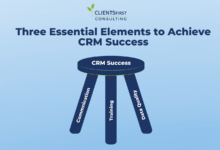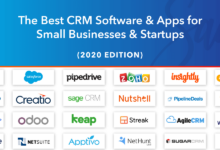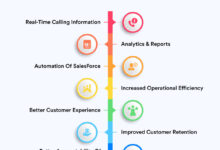Call Center Software CRM: Boosting Efficiency
Call center software CRM revolutionizes customer interaction. It seamlessly blends the power of call center technology with the data-driven insights of a CRM, creating a unified platform for managing customer relationships and improving operational efficiency. This integration streamlines workflows, enhances agent performance, and ultimately leads to a better customer experience. We’ll explore the benefits, features, and implementation strategies for successful integration.
From improving call routing and providing agents with real-time customer data to automating tasks and generating insightful reports, a well-integrated system offers a competitive edge. We’ll delve into the various integration methods, pricing models, and critical considerations for choosing the right software to meet your specific needs. Understanding the key features and potential pitfalls will be crucial in maximizing your return on investment.
Defining Call Center Software and CRM Integration
Okay, let’s get down to brass tacks. Integrating call center software with a CRM system is crucial for modern businesses aiming for efficient customer service and streamlined operations. This integration allows for a seamless flow of customer information, leading to improved agent performance and a better overall customer experience.
Call Center Software Core Functionalities
Call center software is the backbone of any successful customer service operation. Its core functionalities revolve around managing and optimizing incoming and outgoing calls. This includes features like call routing (distributing calls efficiently to available agents), call queuing (managing waiting calls), call recording (for quality assurance and training), and agent performance monitoring (tracking key metrics like call handling time and resolution rate). Advanced systems also offer features like interactive voice response (IVR) systems, which automate initial interactions with callers, and predictive dialing, which automatically dials numbers and connects agents to available customers.
CRM System Key Features
A Customer Relationship Management (CRM) system is designed to manage and analyze customer interactions and data throughout the customer lifecycle. Key features include contact management (storing and organizing customer information), lead management (tracking potential customers), sales management (tracking sales opportunities and closing deals), marketing automation (automating marketing tasks), and reporting and analytics (providing insights into customer behavior and performance). A robust CRM provides a centralized repository of customer information, accessible to all relevant departments within a company.
Call Center Software Integration with CRM Systems
The integration of call center software and a CRM system creates a powerful synergy. When integrated, the call center software automatically pulls up the customer’s profile in the CRM system when a call is received. This provides the agent with immediate access to the customer’s history, purchase details, previous interactions, and other relevant information. This context allows for personalized and efficient service, leading to increased customer satisfaction and reduced resolution times. Conversely, information recorded during calls, such as notes or updates on customer issues, is automatically updated in the CRM, maintaining a complete and up-to-date record of the customer interaction.
Examples of Successful Call Center Software CRM Integrations
Many companies have successfully integrated their call center software and CRM systems. For example, a large telecommunications company might integrate their call center system with Salesforce, allowing agents to access customer account details, service history, and billing information during calls. Similarly, an e-commerce business might use Zendesk integrated with their Shopify store, providing customer service agents with instant access to order details, shipping information, and product specifications. These integrations result in faster resolution times, increased customer satisfaction, and improved operational efficiency.
Comparison of Different Integration Methods
Different methods exist for integrating call center software and CRM systems. The optimal approach depends on the specific needs and technical capabilities of the organization.
| Integration Method | Description | Pros | Cons |
|---|---|---|---|
| API Integration | Direct connection between the two systems via Application Programming Interfaces. | Robust, flexible, real-time data synchronization. | Requires technical expertise, potentially more expensive to implement. |
| Cloud-Based Integration | Both systems are hosted on the cloud and integrate through a shared platform or service. | Easier to implement, often more cost-effective. | Reliance on third-party cloud provider, potential security concerns. |
| Pre-built Connectors | Ready-made connectors from software vendors that facilitate integration. | Quick and easy implementation, usually less expensive. | Limited customization options, may not fit all specific needs. |
| Custom Integration | Tailored integration developed specifically for the organization’s unique requirements. | Highly customizable, optimal fit for specific needs. | Most expensive and time-consuming option, requires significant technical expertise. |
Benefits of Integrating Call Center Software and CRM
Integrating your call center software with your CRM system isn’t just a nice-to-have; it’s a game-changer. It unlocks a wealth of benefits that directly impact customer satisfaction, agent performance, and ultimately, your bottom line. This integration creates a seamless flow of information, providing a 360-degree view of each customer interaction.
Improved Customer Service Experiences Resulting from Integration
Seamless integration allows agents to access complete customer profiles instantly, including past interactions, purchase history, and preferences. This eliminates the need for repetitive questioning and allows agents to personalize interactions, leading to increased customer satisfaction and loyalty. For example, imagine an agent knowing a customer’s recent purchase and proactively offering assistance with setup or troubleshooting. This personalized approach fosters trust and strengthens the customer relationship, significantly reducing customer frustration.
Agent Productivity and Efficiency
Access to comprehensive customer data significantly reduces the time agents spend searching for information. This streamlined workflow empowers agents to handle more calls efficiently, improving their overall productivity. Integrated systems often automate tasks like call routing and data entry, freeing up agents to focus on providing excellent customer service. A study by Aberdeen Group found that companies with integrated systems saw a 25% increase in agent productivity. This translates to handling more calls, resolving issues faster, and ultimately, providing a better customer experience.
Enhanced Data Analysis and Reporting Capabilities
The combined data from call center software and CRM provides a rich source of insights into customer behavior, agent performance, and overall call center efficiency. This data can be used to identify trends, improve processes, and optimize resource allocation. For example, detailed call recordings and customer interaction data can be analyzed to identify common issues or areas for improvement in product design or customer service training. These insights allow for data-driven decision-making, leading to continuous improvement in both customer service and operational efficiency.
Cost-Saving Opportunities from Streamlined Workflows
Integration automates many manual tasks, such as data entry and report generation, reducing operational costs. Improved agent efficiency also contributes to cost savings, as fewer agents are needed to handle the same call volume. The reduction in errors resulting from automated data entry further minimizes costs associated with correcting mistakes or resolving issues stemming from inaccurate information. For example, eliminating the need for manual data entry can save significant time and resources, especially in high-volume call centers.
Improved Sales Conversion Rates
With a complete view of the customer journey, sales agents can identify opportunities to upsell or cross-sell products or services more effectively. This personalized approach, empowered by the integrated system’s data-driven insights, significantly increases the likelihood of successful sales conversions. For instance, knowing a customer’s past purchases allows an agent to suggest relevant complementary products, increasing the chance of a successful upsell. This data-driven approach to sales allows for more targeted and effective sales strategies, leading to improved conversion rates and increased revenue.
Key Features of Integrated Call Center Software CRM Systems
Integrating call center software with a CRM system creates a powerful synergy, boosting efficiency and improving customer experience. This integration streamlines workflows, provides agents with crucial customer information at their fingertips, and offers valuable insights for performance optimization. Let’s delve into the key features that make this integration so effective.
Call Routing and Distribution Features
Effective call routing and distribution are crucial for minimizing wait times and ensuring calls reach the most appropriate agent. Integrated systems offer sophisticated features to achieve this. For instance, intelligent routing algorithms can analyze caller information (from the CRM) and route calls based on factors like customer history, purchase data, or the nature of the issue. Skill-based routing assigns calls to agents with the expertise to handle specific requests. Automatic call distribution (ACD) ensures even call distribution among agents, preventing overload on specific individuals. A queue management system with call-back options minimizes customer frustration during peak hours.
Real-time Customer Data Access for Agents
Having real-time access to complete customer data empowers agents to provide personalized and efficient service. Integrated systems display a comprehensive customer profile, including past interactions, purchase history, preferences, and any outstanding issues, directly within the agent’s interface. This eliminates the need for agents to manually search for information, saving time and improving the overall customer experience. Imagine an agent instantly seeing a customer’s past service requests and purchase history before even answering the phone – a significant improvement over traditional methods.
Automated Call Logging and Recording Features
Automated call logging and recording are vital for quality assurance, training, and compliance. The integrated system automatically logs call details, including date, time, duration, agent, and customer information. Call recording allows for reviewing interactions to identify areas for improvement in agent performance or training needs. This functionality also provides valuable data for analyzing call trends and identifying common customer issues. Moreover, recordings can be used for training purposes, showcasing best practices and highlighting areas where agents can enhance their skills. The system can even transcribe calls for easier analysis.
Agent Performance Tracking Features
Monitoring and analyzing agent performance is crucial for identifying strengths and weaknesses and for providing targeted training. Integrated systems provide various metrics to track agent performance, such as average handling time (AHT), call resolution rate, customer satisfaction scores (CSAT), and adherence to call scripts. Real-time dashboards provide an overview of agent performance, allowing supervisors to identify agents who need support or additional training. Detailed reports can be generated to analyze performance trends and identify areas for improvement. For example, if the AHT is consistently high for a particular agent, supervisors can provide coaching on efficiency techniques.
Hypothetical System Architecture Diagram
Imagine a system where the call center software (e.g., a Cisco contact center solution) acts as the primary interface for handling incoming and outgoing calls. This software integrates seamlessly with a CRM system (e.g., Salesforce) via an Application Programming Interface (API). The API acts as a bridge, allowing the call center software to access and update customer data in real-time. When a call arrives, the call center software uses its routing algorithms (considering data from the CRM) to direct the call to the appropriate agent. The agent’s interface displays the customer’s profile from the CRM. During the call, the system automatically logs the interaction. After the call, data (call duration, resolution status, etc.) is automatically updated in the CRM. The entire process is automated, ensuring efficient workflow and data synchronization. A central database stores all customer data and call records, allowing for comprehensive reporting and analytics. This integrated system offers a robust and scalable solution for managing customer interactions and improving operational efficiency.
Final Thoughts
Integrating call center software and CRM is no longer a luxury, but a necessity for businesses striving for excellence in customer service and operational efficiency. By strategically choosing and implementing the right system, companies can unlock significant benefits, from improved agent productivity and enhanced data analysis to increased sales conversion rates and cost savings. The journey to a more efficient and customer-centric operation starts with understanding the power of this integrated solution.





